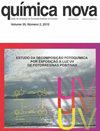QUESTÕES REGULATÓRIAS SOBRE A DESINFECÇÃO DA ÁGUA E O IMPACTO DA GERAÇÃO DE DBPs NA QUALIDADE DA ÁGUA TRATADA
IF 0.5
4区 化学
Q4 CHEMISTRY, MULTIDISCIPLINARY
引用次数: 0
Abstract
REGULATORY ISSUES ON WATER DISINFECTION AND THE IMPACT OF DBP GENERATION ON DRINKING WATER QUALITY. Drinking water disinfection has been viewed as one of the major advances in public health protection in history. However, while it has been very successful in assuring microbiological safety, disinfection also brought relevant concerns about chemical safety and the potential unintended health hazards associated with disinfection byproduct (DBP) exposure. DBPs represent one of the most important groups of chemical compounds to which humans are exposed through drinking water, as epidemiological studies have consistently associated long-term exposure with multiple adverse health effects. It is established that disinfection is an essential component of providing microbiologically safe drinking water and shall never be compromised. Yet, chemical safety regarding DBP exposure remains a largely uncovered and highly discussed topic. Several DBPs have been reported in the past few decades, yet research on formation, toxicity and occurrence remains scarce for most compounds. Also, for each identified DBP, many remain undiscovered. In view of an ever-growing list of DBPs and the existing gaps in available research, identifying overall driving agents of toxicity is still a major challenge for public health protection. This review attempts to provide an insight on contemporary issues regarding the overall safety of drinking water and the trade-off between microbiological and chemical risks, considering current challenges in water and sanitation access and existing regulations.关于水消毒的监管问题和DBPs的产生对处理过的水质量的影响
有关水消毒的规管问题及DBP的产生对饮用水水质的影响。饮用水消毒一直被视为历史上公共卫生保护的重大进步之一。然而,尽管消毒在确保微生物安全方面非常成功,但它也带来了对化学品安全的相关担忧,以及与消毒副产物(DBP)接触相关的潜在意外健康危害。dbp是人类通过饮用水接触到的最重要的一类化合物,因为流行病学研究一直将长期接触dbp与多种不利健康影响联系起来。现已确定,消毒是提供微生物安全饮用水的重要组成部分,绝不应妥协。然而,与DBP接触有关的化学品安全仍然是一个很大程度上未被发现和高度讨论的话题。在过去的几十年里,已经报道了几种dbp,但对大多数化合物的形成、毒性和发生的研究仍然很少。此外,对于每一个确定的DBP,许多仍未被发现。鉴于dbp的清单不断增加以及现有研究中存在的差距,确定毒性的总体驱动因子仍然是保护公众健康的一项重大挑战。考虑到当前在水和卫生设施获取方面的挑战以及现有法规,本综述试图提供有关饮用水总体安全以及微生物和化学风险之间权衡的当代问题的见解。
本文章由计算机程序翻译,如有差异,请以英文原文为准。
求助全文
约1分钟内获得全文
求助全文
来源期刊

Quimica Nova
化学-化学综合
CiteScore
1.60
自引率
12.50%
发文量
72
审稿时长
2-4 weeks
期刊介绍:
Química Nova publishes in portuguese, spanish and english, original research articles, revisions, technical notes and articles about education in chemistry. All the manuscripts submitted to QN are evaluated by, at least, two reviewers (from Brazil and abroad) of recognized expertise in the field of chemistry involved in the manuscript. The Editorial Council can be eventually asked to review manuscripts. Editors are responsible for the final edition of QN.
 求助内容:
求助内容: 应助结果提醒方式:
应助结果提醒方式:


